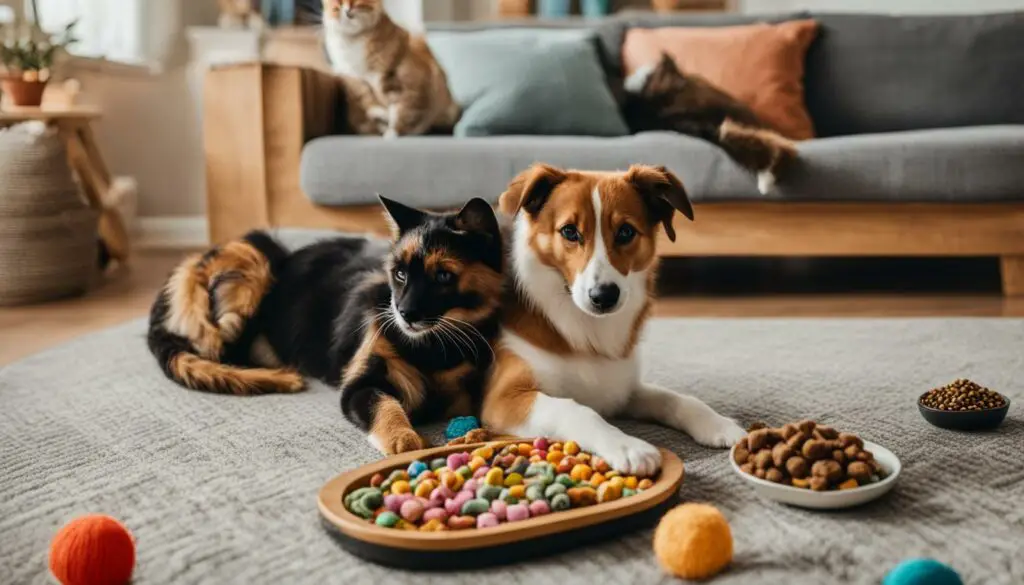Are you struggling to create harmony between your cat and dog? As a pet expert with a deep understanding of animal behavior, I’m here to provide you with valuable insights and techniques to make their relationship a happy and peaceful one.
Introducing pets can be a delicate process, but with the right approach, positive reinforcement, and effective training techniques, you can foster effective communication, mutual respect, and strong bonds between your furry friends. Understanding their body language, territorial instincts, and hierarchy dynamics is essential for their coexistence.
Key Takeaways:
- Proper introductions and gradual integration are crucial for creating a harmonious relationship between cats and dogs.
- Socialization and positive reinforcement techniques can help build trust and friendship between your pets.
- Observing body language and addressing setbacks promptly are important in resolving conflicts and ensuring a peaceful environment.
- Individual personalities and breed characteristics should be considered in tailoring the introduction process.
- Seeking professional guidance and incorporating holistic approaches can contribute to a successful and lasting bond between cats and dogs.
Understanding the Dynamics of Dogs and Cats
When it comes to the dynamics between dogs and cats, it’s important to recognize their inherent differences in behavior and communication. Dogs are pack animals, driven by a need for hierarchy and structure, while cats are solitary creatures with strong territorial instincts. These fundamental differences can greatly impact their interactions and coexistence. To foster a harmonious relationship between cats and dogs, we must first understand and appreciate their unique characteristics.
Socialization and Communication
Socialization plays a crucial role in shaping the behavior of both dogs and cats. Dogs are typically more open to socialization and rely heavily on body language and vocalizations to communicate their intentions. Cats, on the other hand, are more independent and communicate through subtle cues, such as tail flicks and ear positions. Understanding and interpreting these signals is essential in facilitating positive interactions between your furry companions.
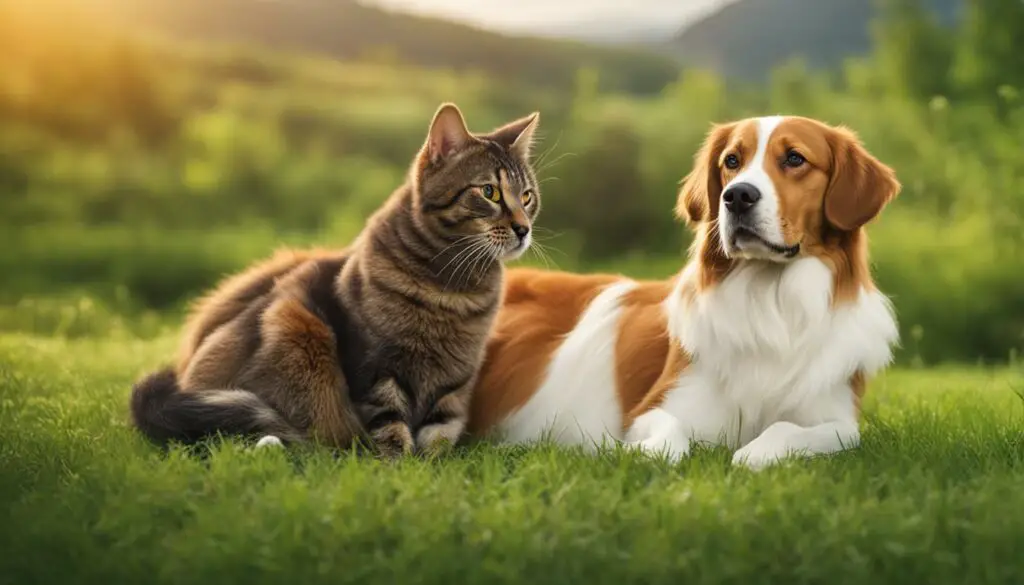
Bonding and Friendship
Bonding between dogs and cats can take time and patience. Creating opportunities for positive associations and shared experiences can help establish a foundation of trust and respect. Encouraging supervised play sessions, providing environmental enrichment, and promoting positive reinforcement can all contribute to the development of a strong bond between your pets. It’s important to remember that each cat and dog is unique, and the pace at which they form a friendship will vary.
Territorial Instincts and Hierarchy
Understanding and managing territorial instincts is crucial when introducing cats and dogs. Dogs have a natural inclination to establish a hierarchy, while cats are more inclined to defend their territory. It’s essential to provide separate spaces for each pet to retreat to, ensuring they feel safe and secure. Gradual introductions and monitored interactions can help establish boundaries and minimize potential conflicts.
By understanding the dynamics of dogs and cats, we can create an environment that promotes understanding, respect, and ultimately, a harmonious coexistence between these beloved pets.
Preparing for a Peaceful Introduction
Introducing pets can be a delicate process that requires careful preparation and consideration. Setting the stage for a peaceful introduction can greatly increase the chances of a positive outcome and successful bonding between your cat and dog. Here are some important steps to follow:
Creating Individual Spaces
Before bringing your cat and dog together, it’s essential to provide them with their own designated spaces in the house. This will allow each pet to retreat to a secure and comfortable area when needed. Make sure to equip these spaces with their favorite toys, bedding, and litter box for the cat. Having their own territory will contribute to a sense of security and reduce potential territorial conflicts.
Gradual Scent Familiarization
Introducing the scents of both pets before any visual contact can help them become familiar with each other’s presence. You can accomplish this by swapping bedding or using a soft cloth to collect the scent of one pet and placing it near the other’s designated area. This gradual scent familiarization will help reduce initial anxiety and create a sense of familiarity when they finally meet face-to-face.
Using a Barrier for Initial Visual Contact
When it’s time for the first visual interaction, it’s best to use a barrier such as a baby gate or mesh screen. This will allow your cat and dog to see each other without any direct physical contact, ensuring their safety. Observe their body language during this initial phase to assess their comfort levels. If any signs of stress or aggression are present, it’s important to slow down the introduction process and give them more time to adjust.
| Benefits of Preparing for a Peaceful Introduction | Benefits of Gradual Scent Familiarization |
|---|---|
| Promotes a sense of security for each pet | Reduces initial anxiety and stress |
| Minimizes potential territorial conflicts | Creates a sense of familiarity |
| Allows pets to establish their own territories | Builds a foundation for a positive introduction |
By following these steps and taking the time to prepare for a peaceful introduction, you can set the stage for a positive and harmonious relationship between your cat and dog. Remember to be patient and observant during the process, and always prioritize the safety and well-being of both pets.
Step-by-Step Introduction Process
Introducing a cat and dog requires a gradual and supervised approach to ensure a smooth transition and minimize stress. Here is a step-by-step process to help you bring your furry friends together:
- Confinement and Scent Swapping: Start by confining one pet to a separate area while allowing the other pet to explore the house. This allows them to become familiar with each other’s scents. Switch their roles after a few days to continue the scent swapping process.
- Visual Interaction: Once the pets are comfortable with each other’s scents, it’s time to introduce them visually. Use a barrier such as a baby gate or mesh screen to allow them to see each other while maintaining safety. Observe their body language during this phase to ensure they are comfortable.
- Supervised Interactions: As the pets become more accustomed to each other’s presence, start introducing supervised interactions in a neutral territory, such as a seldom-used room or hallway. Keep the initial sessions short and gradually increase the duration over time.
- Positive Associations: During the supervised interactions, reward your pets with treats, praise, and affection for calm and friendly behavior. This helps them associate each other’s presence with positive experiences, building trust and camaraderie.
Remember, every cat and dog is unique, and the introduction process may vary. Keep a close eye on their behavior, and if any signs of aggression or stress arise, take a step back and consult with a professional for further guidance.
Table: Gradual Introduction Framework
| Step | Activity |
|---|---|
| 1 | Confinement and scent swapping |
| 2 | Visual interaction with a barrier |
| 3 | Supervised interactions in a neutral territory |
| 4 | Positive associations and rewards |
By following this step-by-step process, you can set the foundation for a successful and harmonious relationship between your cat and dog. Gradual introductions, scent swapping, supervised interactions, and positive associations are key to building trust and creating a bond that will last a lifetime.
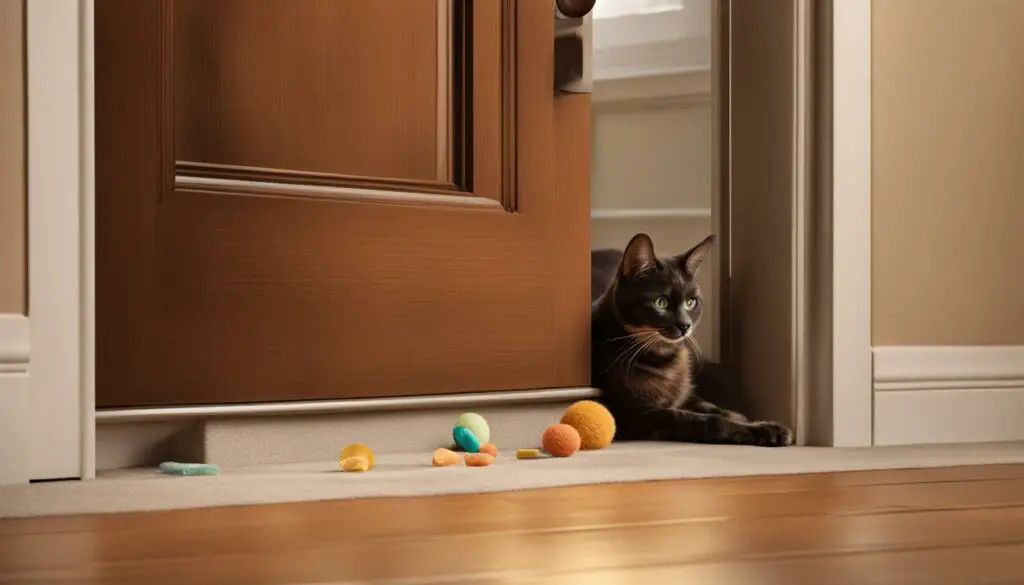
Addressing Setbacks and Challenges
While introducing cats and dogs can lead to a harmonious coexistence, it is important to be aware of potential setbacks and challenges that may arise along the way. These challenges can include conflict resolution, fear aggression, resource guarding, and separation anxiety. Patience and professional guidance are key in navigating these issues and creating a peaceful environment for both pets.
Conflict resolution is a crucial skill to have when bringing cats and dogs together. It is normal for there to be some initial tension and disagreements as they establish their hierarchy and boundaries. However, if aggression or fights occur, it is important to address it promptly and seek professional guidance. A pet behaviorist or veterinarian can provide expert advice and strategies to help manage and resolve these conflicts.
Fear aggression is another challenge that may arise during the introduction process. Some cats and dogs may exhibit fear-based aggression due to past experiences or trauma. It is essential to create a safe and secure environment for both pets and gradually expose them to positive experiences to build trust and confidence. Professional guidance can play a crucial role in helping pets overcome fear aggression and develop more positive behaviors.
Resource guarding, where pets become protective of their toys, food, or favorite spots, is another challenge to be aware of. This behavior can lead to conflicts and tension between cats and dogs. It is important to establish clear rules and boundaries around resource sharing and seek professional guidance to address and manage this issue effectively.
Separation anxiety is a common challenge that can affect both cats and dogs. When introducing pets, it is important to gradually increase the time they spend apart to prevent separation anxiety from developing. Positive reinforcement, environmental enrichment, and creating a routine can help alleviate separation anxiety. If the behavior persists or worsens, consulting with a veterinarian or professional behaviorist is advised.
| Challenges | Solutions |
|---|---|
| Conflict Resolution | Seek professional guidance, establish boundaries, and provide positive reinforcement. |
| Fear Aggression | Create a safe environment, gradual exposure to positive experiences, and seek professional guidance. |
| Resource Guarding | Establish clear rules and boundaries, seek professional guidance, and manage resource sharing. |
| Separation Anxiety | Gradual separation, positive reinforcement, environmental enrichment, and consult with a veterinarian or behaviorist. |
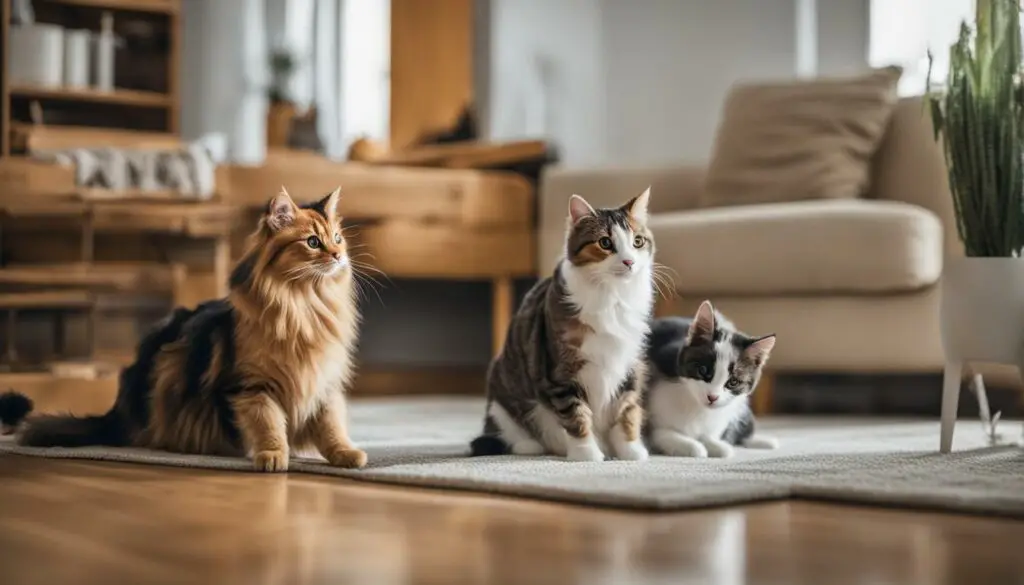
Remember, addressing setbacks and challenges requires patience and understanding. Every cat and dog is unique, and their behavior may vary. It is important to approach these challenges with empathy and seek professional guidance when needed. With time, effort, and the right strategies, you can create a peaceful environment and foster a harmonious relationship between your cats and dogs.
Building a Lasting Bond
Bonding between a cat and dog takes time and requires efforts to build trust and mutual understanding. Providing leadership and guiding their interactions can help establish a hierarchy and minimize conflicts. Empathy and understanding their individual needs and preferences are crucial in nurturing their bond. Environmental enrichment, such as providing interactive toys and engaging in shared activities, can promote positive associations. Recognizing and responding to calming signals from both pets can contribute to their overall well-being and a harmonious coexistence.
Creating a lasting bond between a cat and dog involves several key elements. Leadership is essential in establishing a structure and hierarchy in their relationship. This can be achieved by setting clear boundaries and consistently enforcing rules. By taking on the role of a confident and assertive leader, you can help create a sense of security and trust for both pets.
Empathy is also important in building a bond between a cat and dog. Understanding their individual needs, preferences, and communication styles will enable you to meet their specific requirements and create a harmonious environment. This includes recognizing their body language and responding to their calming signals. By being attentive and responsive, you can foster a sense of safety and understanding.
Environmental enrichment plays a crucial role in bonding and trust-building between cats and dogs. Providing interactive toys, engaging in shared activities, and creating opportunities for positive experiences can help create positive associations and strengthen their bond. By creating a stimulating and enjoyable environment, you can encourage them to interact and engage with each other in a positive manner.
| Key Elements for Building a Lasting Bond Between Cats and Dogs |
|---|
| Leadership |
| Empathy |
| Understanding |
| Environmental Enrichment |
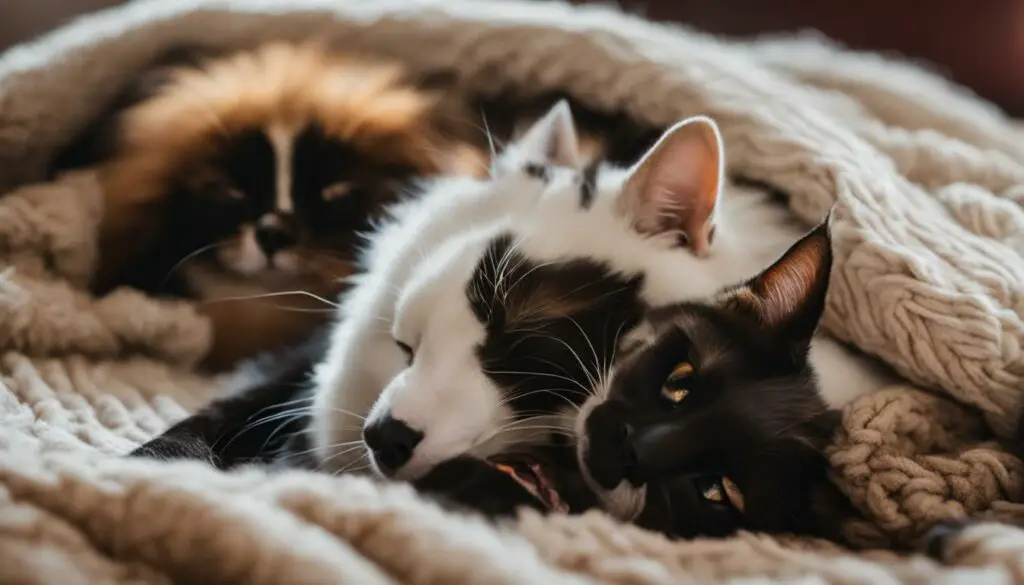
“Building a lasting bond between a cat and dog requires leadership, empathy, understanding, and environmental enrichment. By providing clear guidance, recognizing their individual needs, and creating a stimulating environment, you can foster a strong and harmonious relationship between them.” – Pet Expert
Section 7: Establishing Routines and Consistency
In order to create a peaceful environment for both cats and dogs, it is important to establish routines and consistency in their daily lives. This helps them feel secure and reduces stress, fostering a harmonious cohabitation. Routines provide structure and predictability, which can greatly benefit pets and contribute to their overall well-being. Consistency in their care and interactions is key to maintaining a harmonious coexistence.
A reward-based training approach should be used consistently to reinforce positive behaviors. By rewarding desired behaviors and redirecting unwanted ones, pets learn what is expected of them and how to behave appropriately. This approach not only enhances their training but also strengthens the bond between pets and their owners.
Providing clear leadership is crucial in ensuring a peaceful environment. Pets thrive when they have a leader who establishes rules and boundaries. This leadership helps minimize conflicts and establishes a sense of order within the household. By providing consistent guidance and reinforcing positive behaviors, pet owners can create a peaceful and respectful atmosphere.
| Benefit of Establishing Routines and Consistency | Examples |
|---|---|
| Reduced stress | – Maintaining regular feeding, play, and exercise times – Consistent bedtime routines |
| Enhanced training | – Using the same cues and commands consistently – Rewarding desired behaviors consistently |
| Established hierarchy | – Providing clear leadership through consistent guidance – Reinforcing positive behaviors consistently |
In conclusion, establishing routines and consistency is essential for creating a peaceful environment for cats and dogs. By providing structure, rewarding positive behaviors, and establishing clear leadership, pet owners can ensure a harmonious cohabitation. Consistency in their care and interactions fosters trust and mutual respect, strengthening the bond between pets and their owners. With these practices in place, cats and dogs can thrive in a peaceful and loving home.
Understanding Individual Personalities and Breed Characteristics
When it comes to bringing a cat and dog together, it’s important to remember that each pet has their own unique personality and breed characteristics. These factors play a significant role in their behavior, socialization needs, and communication styles. Understanding these individual traits is crucial in ensuring a successful and harmonious introduction and coexistence between the two pets.
Just like humans, cats and dogs have distinct personalities. Some cats may be more sociable and outgoing, while others may be more reserved and independent. Similarly, dogs can vary in their energy levels, trainability, and sociability. By understanding the individual personalities of your cat and dog, you can tailor the introduction process to their specific needs and preferences.
Breed characteristics also play a role in how cats and dogs interact with one another. Some dog breeds have a high prey drive, which may make them more likely to chase or be aggressive towards cats. On the other hand, certain cat breeds may be more tolerant and adaptable to living alongside dogs. It’s important to research the specific breed characteristics of both your cat and dog to anticipate any potential challenges or compatibility issues.
By taking into account the individual personalities and breed characteristics of your cat and dog, you can create a tailored approach to their introduction and ensure a smoother transition into a harmonious and loving relationship.
| Cat Personalities | Dog Personalities |
|---|---|
| Outgoing | High Energy |
| Reserved | Laid-back |
| Independent | Trainable |
Incorporating Holistic Approaches and Natural Remedies
When it comes to creating a peaceful environment for cats and dogs, incorporating holistic approaches and natural remedies can play a significant role. These methods focus on reducing stress, promoting relaxation, and improving overall well-being for our furry friends. By understanding animal psychology and utilizing natural remedies, we can enhance the bond between cats and dogs and create a harmonious coexistence.
One holistic approach to consider is the use of pheromone diffusers, which emit substances that mimic comforting scents for cats and dogs. These diffusers can help reduce anxiety and create a calming atmosphere in the home. Additionally, calming herbal supplements or essential oils can be used to promote relaxation and reduce stress. However, it is important to consult with a veterinarian or holistic pet expert to ensure the safety and appropriateness of these remedies for your specific pets.
“By incorporating holistic approaches and natural remedies, pet owners can create a peaceful environment that promotes stress reduction and enhances the bond between their cats and dogs.”
Understanding animal psychology is also crucial in identifying the most effective holistic approaches for individual pets. Each cat and dog has unique needs and preferences, and what works for one may not work for another. By observing their behavior and responses to different remedies, we can tailor our approach and find the best solutions for their well-being. Professional guidance from a veterinarian or holistic pet expert can provide valuable insights and recommendations in this regard.
Incorporating holistic approaches and natural remedies is just one piece of the puzzle in achieving harmony between cats and dogs. It should be combined with other strategies such as positive reinforcement, proper introductions, and consistent routines. By taking a holistic and comprehensive approach, we can create a peaceful environment that fosters strong bonds and mutual well-being for our furry companions.
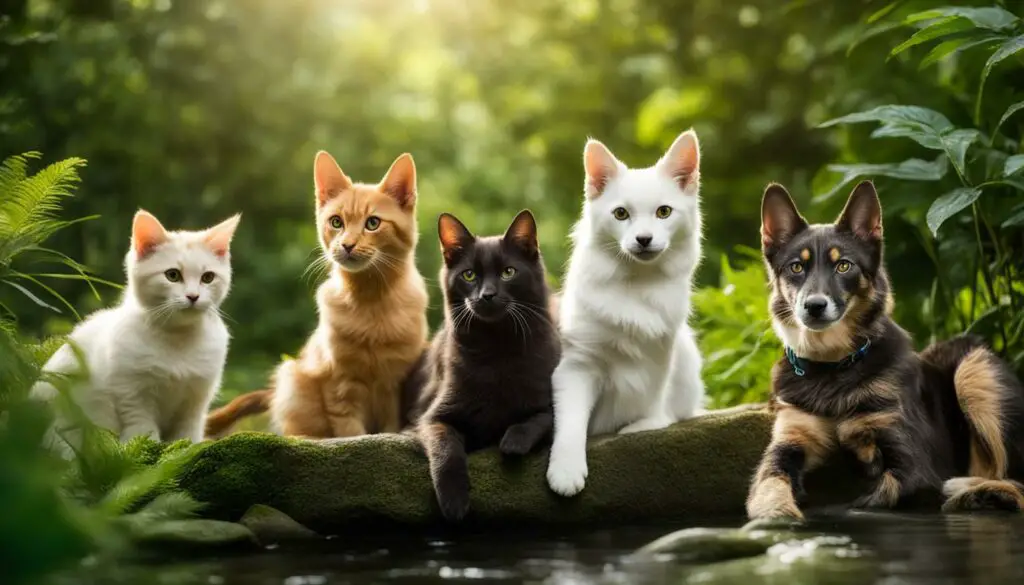
Table: Comparison of Holistic Approaches and Natural Remedies
| Holistic Approach/Remedy | Description | Benefits |
|---|---|---|
| Pheromone Diffusers | Devices that release synthetic substances mimicking natural pheromones to create a calming effect | Reduces anxiety and promotes relaxation |
| Calming Herbal Supplements | Natural supplements containing herbs with relaxing properties | Helps alleviate stress and anxiety |
| Aromatherapy | Use of essential oils with soothing scents to create a calming atmosphere | Promotes relaxation and reduces stress |
| Music Therapy | Playing calming music designed specifically for pets | Creates a peaceful environment and helps reduce anxiety |
Note: It is important to consult with a veterinarian or holistic pet expert before incorporating any holistic approaches or natural remedies, as individual pets may have specific requirements or sensitivities.
Seeking Professional Guidance and Veterinary Advice
When it comes to resolving complex issues and ensuring a harmonious relationship between our furry friends, seeking professional guidance and veterinary advice is crucial. Pet behaviorists and trainers are equipped with the knowledge and expertise to address specific behavioral problems and provide tailored strategies and techniques. They can assess the individual needs and personalities of your cat and dog and offer guidance on introducing them, resolving conflicts, and nurturing their bond.
Veterinary advice is also essential in ruling out any underlying medical conditions that may contribute to behavioral problems. A thorough examination and consultation with a veterinarian can help identify any health issues that need to be addressed. By collaborating with professionals and veterinarians, pet owners can find the most appropriate solutions for creating a peaceful and happy environment for both cats and dogs.
Understanding animal behavior, training techniques, and conflict resolution methods can be challenging, which is why professional guidance is invaluable. By relying on the expertise of pet professionals and veterinarians, pet owners can navigate the intricacies of cat-dog dynamics with confidence and ensure the well-being of their beloved pets.
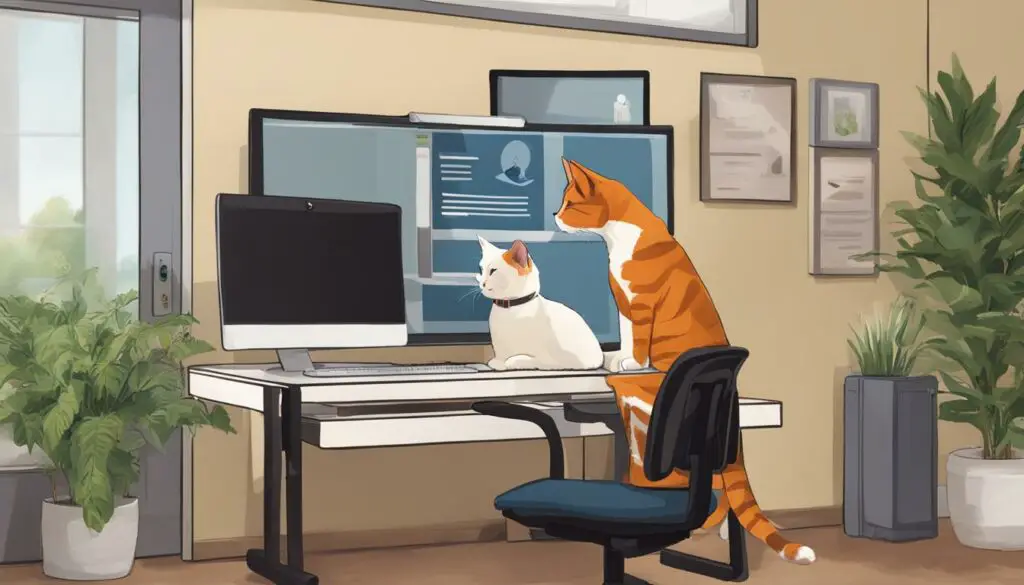
H3: Case Study: Resolving Intercanine Aggression
“Working with a pet behaviorist was a game-changer for us. Our two dogs were constantly fighting, and we were at our wit’s end. With their guidance, we learned how to better understand their triggers, redirect their behavior, and establish a more structured environment. We saw significant improvements in their interactions, and they are now able to peacefully coexist. Professional guidance truly saved our relationship with our dogs.”
Table: Comparison of Training Techniques for Cat and Dog Integration
| Training Technique | Advantages | Disadvantages |
|---|---|---|
| Positive Reinforcement | Effective in promoting desired behaviors | Time-consuming and requires consistency |
| Desensitization | Gradual exposure helps reduce fear and anxiety | Requires careful planning and execution |
| Counterconditioning | Helps create positive associations with previously feared stimuli | May take time for noticeable results |
| Clicker Training | Precise and clear communication with pets | Requires learning and mastering the technique |
Pet Ownership and Responsible Pet Care
As a pet owner, it is our responsibility to ensure the well-being and happiness of our furry companions. Pet ownership goes beyond providing food and shelter; it requires dedication, commitment, and responsible care. By establishing routines, maintaining consistency, and prioritizing their environmental enrichment, we can create a safe and nurturing environment for our pets.
Consistency is key in pet care. Whether it’s sticking to regular feeding schedules or implementing a daily exercise routine, our pets thrive on predictability. Consistent routines help them feel secure and reduce stress. Additionally, positive reinforcement training techniques can be used to teach and reinforce desired behaviors, fostering a harmonious relationship between pet and owner.
Environmental enrichment is vital for the overall well-being of our pets. Providing toys, interactive games, and opportunities for mental stimulation can prevent boredom and destructive behavior. It is important to consider the specific needs and preferences of our pets when choosing enrichment activities. For example, a puzzle toy filled with treats can keep a dog entertained while a scratching post can satisfy a cat’s natural instinct to claw.
Pet Ownership and Veterinary Care
Veterinary care is an essential aspect of responsible pet ownership. Regular check-ups, vaccinations, and preventive treatments ensure the health and longevity of our pets. It is important to consult a veterinarian to establish a proper healthcare plan tailored to the specific needs of our pets. By staying proactive in their medical care, we can prevent potential health issues and address any concerns promptly.
As pet owners, it is our duty to provide a loving and secure environment for our furry friends. Through responsible pet care, consisting of routines, consistency, environmental enrichment, and veterinary care, we can create a happy and healthy life for our beloved pets. Their well-being depends on our commitment and dedication, and in return, they reward us with unconditional love and companionship.
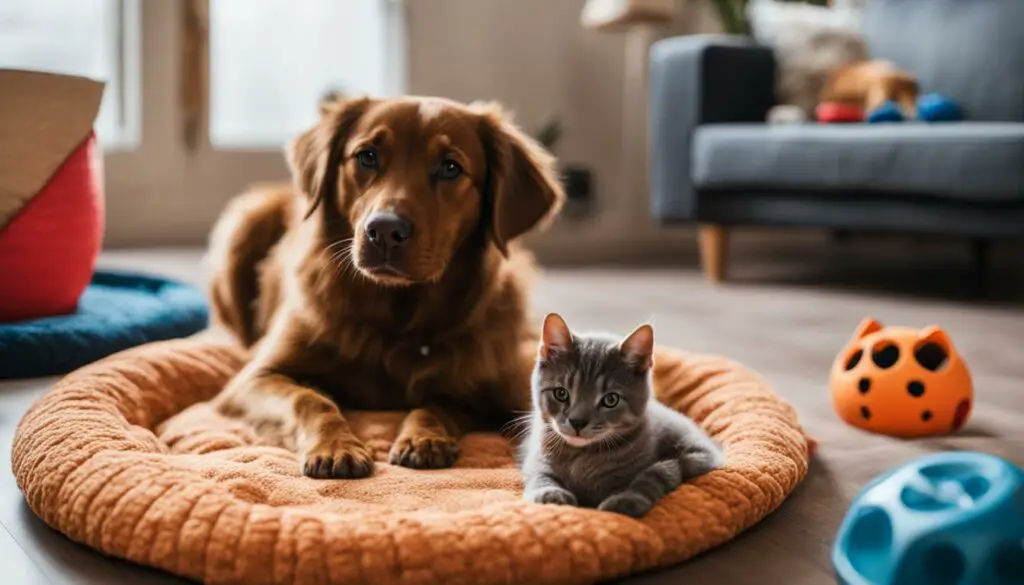
| Key Aspects of Responsible Pet Care | Benefits |
|---|---|
| Establishing routines and consistency | Reduces stress and provides predictability |
| Environmental enrichment | Prevents boredom and destructive behavior |
| Veterinary care | Maintains their health and addresses medical concerns |
| Positive reinforcement training | Fosters a harmonious relationship between pet and owner |
Creating a Peaceful Environment for Cats and Dogs
Creating a peaceful environment for both cats and dogs is essential for their well-being and harmonious cohabitation. By minimizing stressors and providing a calm and quiet space, you can help reduce anxiety and promote a sense of security for your pets.
One way to reduce stress and create a peaceful environment is by establishing routines. Cats and dogs thrive on consistency, so providing them with a predictable daily schedule can help them feel more at ease. This includes regular feeding times, exercise routines, and designated quiet spaces for relaxation. By sticking to a consistent routine, you can help your pets feel safe and minimize any potential conflicts.
Bonding and trust-building are also essential for creating a peaceful environment. Take the time to engage in activities that promote bonding, such as interactive play sessions or calm grooming sessions. Positive reinforcement techniques, such as rewards and praise, can also help strengthen the bond between your pets. By fostering a sense of trust and mutual respect, you can create a harmonious relationship between your cats and dogs.

| Routines and Consistency | Bonding and Trust-Building |
|---|---|
|
|
“Creating a peaceful environment for cats and dogs requires consistency, routine, and intentional efforts to build trust and strengthen their bond. By minimizing stressors, establishing a calm and quiet space, and prioritizing their emotional well-being, pet owners can foster a harmonious coexistence between their furry friends.”
In summary, a peaceful environment for cats and dogs can be achieved by minimizing stressors, establishing routines, and prioritizing bonding and trust-building. By creating a calm and quiet space, sticking to consistent schedules, and engaging in activities that strengthen their bond, pet owners can help their furry friends live in harmony. Remember, patience and empathy are key in fostering a peaceful environment, so take the time to understand and meet the individual needs of your pets.
Embracing the Journey of Cat-Dog Harmony
In the journey of creating a harmonious relationship between cats and dogs, there are key elements that pet owners must embrace. Building a strong bond between these two different species requires patience, understanding, and empathy. It is a process that takes time and effort, but the rewards of cat-dog harmony are well worth it.
Bonding is at the core of establishing a positive connection between cats and dogs. This involves creating opportunities for them to interact and engage in activities together. Through shared experiences, they can gradually build trust and develop a sense of familiarity. Patience is essential during this process, as each pet will have their own pace in warming up to one another.
Effective communication is also vital in the journey of cat-dog harmony. Pet owners must learn to interpret and respond to the body language and signals of their pets. Understanding the subtle cues and recognizing their individual needs will help avoid misunderstandings and potential conflicts.
Empathy plays a significant role in nurturing a peaceful environment for cats and dogs. By putting yourself in their paws, you can better understand their perspectives and provide the necessary support. This includes creating a safe space where both pets feel secure, respecting their boundaries, and addressing any fears or anxieties they may have.
With love, patience, and consistent effort, pet owners can create a harmonious home where cats and dogs coexist in unity. The journey may have its challenges, but by embracing the process and remaining dedicated to building trust, understanding, and empathy, cat-dog harmony can be achieved.
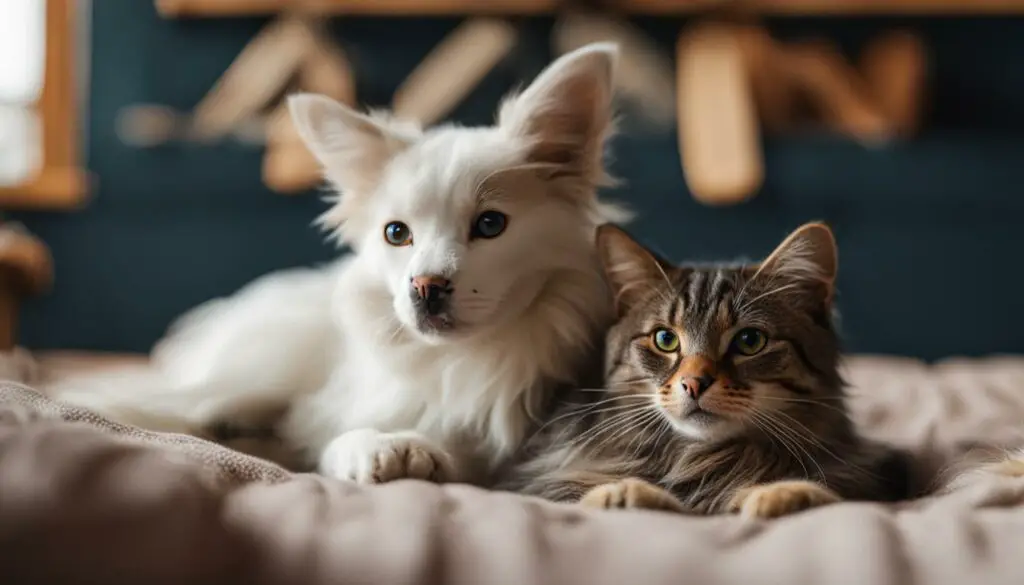
Key Steps in Building Cat-Dog Harmony
- Provide separate dedicated spaces for each pet to feel secure and comfortable.
- Gradually introduce their scents through scent swapping to familiarize them with each other’s presence.
- Use a barrier, such as a baby gate or mesh screen, for their first visual interactions to ensure safety.
- Observe their body language during interactions and adjust the pace accordingly.
- Reward and praise positive behavior to reinforce their amicable interactions.
- Address any signs of fear, aggression, or anxiety promptly and seek professional guidance if needed.
- Establish consistent routines and provide environmental enrichment to reduce stress and promote bonding.
- Practice effective communication by understanding their individual needs and responding to their signals.
Quotes from Pet Experts
“Building a lasting bond between cats and dogs requires dedication and a deep understanding of their unique personalities. Patience and empathy are key in nurturing their relationship and helping them navigate any challenges that may arise.” – Dr. Lisa Johnson, Animal Behaviorist
“By embracing the journey of cat-dog harmony, pet owners not only create a harmonious environment for their pets but also foster a sense of love, compassion, and understanding within their own lives.” – Sarah Thompson, Pet Trainer
Table: Tips for Fostering Cat-Dog Harmony
| Tip | Description |
|---|---|
| Establish a Routine | Create a consistent schedule for feeding, playtime, and rest to provide structure and reduce stress for both pets. |
| Encourage Positive Associations | Reward good behavior and provide treats or playtime together to reinforce positive associations between cats and dogs. |
| Respect Individual Space | Provide separate spaces for each pet to retreat to when they need alone time or feel overwhelmed. |
| Practice Obedience Training | Teach basic commands to both pets to establish boundaries and promote respectful behavior. |
| Monitor Interactions | Supervise their interactions and intervene if necessary to prevent any potential conflicts or accidents. |
Conclusion
In conclusion, creating a harmonious relationship between cats and dogs requires patience, understanding, and commitment. By following proper introductions and focusing on bonding and trust-building, pet owners can help their furry friends get along.
Communication plays a crucial role, as understanding each pet’s individual needs and preferences allows for effective interaction. Positive reinforcement and consistent routines help establish a peaceful environment and reinforce desired behaviors.
Additionally, incorporating holistic approaches can further reduce stress and promote relaxation for both cats and dogs. Consulting with a pet expert or veterinarian can provide valuable insights and guidance on implementing these techniques.
With a little effort and a lot of love, pet owners can foster a strong bond between their cat and dog, creating a happy and harmonious home for both four-legged companions.
FAQ
Can cats and dogs get along?
Yes, cats and dogs can get along. While individual personalities and experiences play a role, proper introductions, positive reinforcement, and mutual respect can help foster a harmonious relationship between them.
How do you introduce a cat and dog?
Introduce a cat and dog gradually and supervised. Start with scent swapping, then allow brief interactions in a neutral territory. Gradually increase their interaction time while observing their body language to assess their comfort level.
What should I do if there are conflicts between my cat and dog?
Address conflicts promptly by seeking professional guidance. A pet behaviorist or veterinarian can provide strategies to resolve aggression, fear, or anxiety between your cat and dog.
Can cats and dogs bond and become friends?
Yes, cats and dogs can bond and become friends. Building trust, providing leadership, and engaging in shared activities can help foster a strong and positive relationship between them.
Are there natural remedies to help reduce stress for cats and dogs?
Yes, there are natural remedies such as pheromone diffusers, calming herbal supplements, and aromatherapy that can help reduce stress and promote relaxation for both cats and dogs.
When should I seek professional guidance and veterinary advice?
Seek professional guidance and veterinary advice when conflicts persist or if you need assistance with training techniques, behavior modification, or addressing specific issues between your cat and dog.
What are the responsibilities of pet ownership and responsible pet care?
Responsibilities include providing proper care, attention, training, and a safe and nurturing environment for your cat and dog. Consistency in routines, environmental enrichment, and regular veterinary care are essential for their overall well-being.
How can I create a peaceful environment for both cats and dogs?
Minimize stressors, provide a calm and quiet space, establish routines, and reduce potential triggers. Bonding, trust-building, and clear communication are key to creating a peaceful environment for your cat and dog.
Is it important to understand individual personalities and breed characteristics?
Yes, understanding individual personalities and breed characteristics is crucial in determining their socialization needs, communication styles, and behavior. It helps tailor the approach when introducing cats and dogs to ensure compatibility.
How can I incorporate holistic approaches and natural remedies?
Holistic approaches such as animal psychology, stress reduction techniques, and natural remedies can be incorporated to promote relaxation and reduce stress for both cats and dogs. Consult with a veterinarian or holistic pet expert for guidance.
What should I do to ensure responsible pet ownership and care?
Responsible pet ownership includes fulfilling their needs, providing proper care, attention, training, and regular veterinary care. Consistency in routines, environmental enrichment, and maintaining a peaceful environment are essential.
How can I embrace the journey of cat-dog harmony?
Embracing the journey involves patience, empathy, and understanding. Focus on bonding, trust-building, effective communication, and celebrating the milestones in their growing connection to create a harmonious coexistence between cats and dogs.

